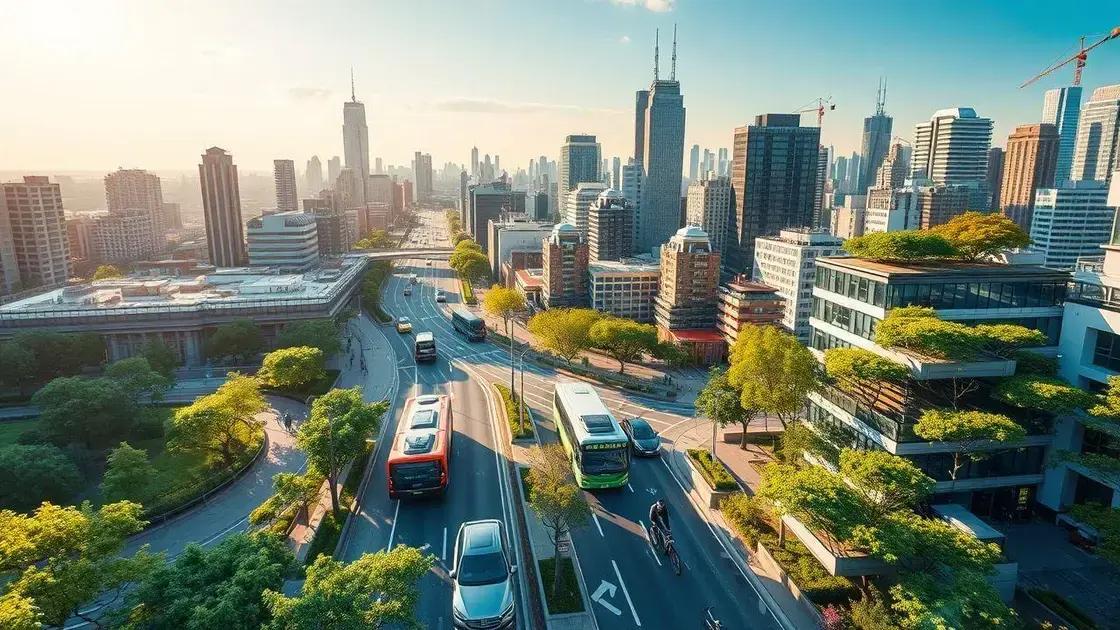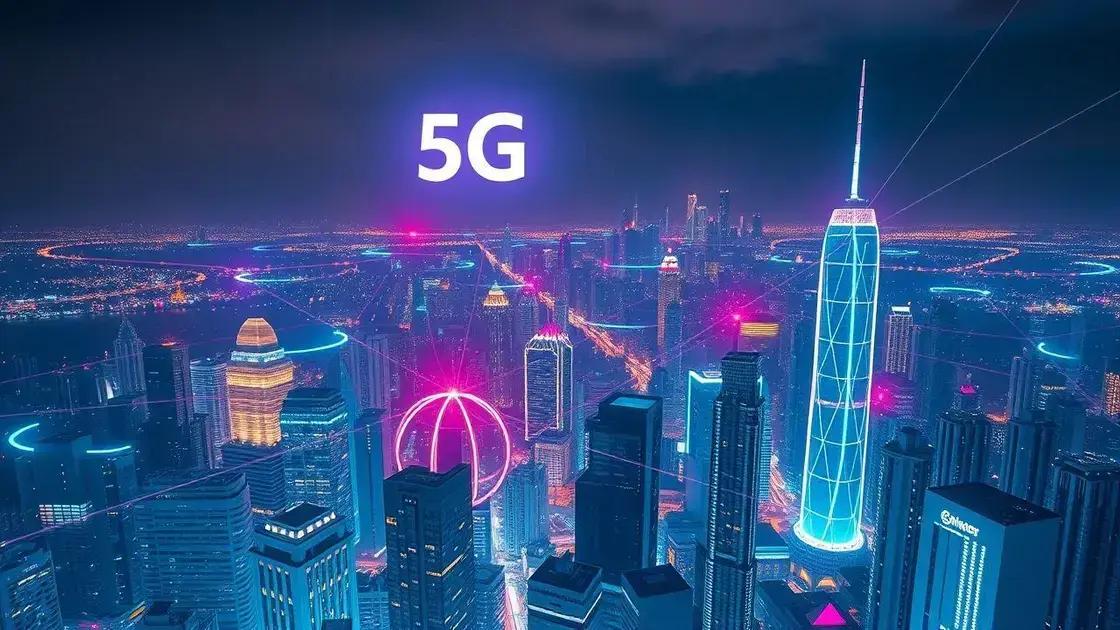Smart city innovations: transforming urban living today

Anúncios
Smart city innovations utilize advanced technologies like IoT and AI to enhance urban living, improve sustainability, and foster greater efficiency in services and infrastructure.
Smart city innovations are reshaping our urban landscapes, influencing how we live, work, and interact. Have you thought about how these changes can enhance your daily life? Let’s delve into the transformative technologies at play.
Anúncios
Understanding smart city innovations
Understanding smart city innovations is essential for anyone interested in how modern technology can improve urban life. Smart city innovations involve the integration of various technologies that make cities more efficient and livable.
Key Features of Smart Cities
One of the main features of smart cities is their ability to use data effectively. Cities harness information from connected devices and sensors to manage resources better. For instance, smart traffic lights adapt to flow patterns, which reduces congestion.
Anúncios
- Data-driven decision-making
- Real-time monitoring of city services
- Increased public engagement
- Sustainable energy use
Another vital aspect is improved transportation systems. With smart city innovations, public transportation becomes more efficient and user-friendly. Application-based services make it easier to access routes and schedules, encouraging more people to use public transit.
Impact on Daily Life
Smart city technologies impact our daily lives significantly. From smart waste management systems that optimize collection routes to apps that help residents find available parking, these innovations ease life in urban environments.
- Reduced travel times
- Lowered energy costs
- Better air quality
- Enhanced public safety
These innovations are not just beneficial for residents but also promote sustainability. By using resources wisely and reducing waste, cities can become more environmentally friendly.
As we explore these concepts, it’s clear that the future of city living relies heavily on smart city innovations. By understanding their implementation and benefits, we can appreciate the transformation in urban life.
Key technologies driving smart cities
Key technologies driving smart cities are crucial for transforming urban areas into efficient and sustainable environments. These technologies ensure that cities can meet the needs of their residents while promoting a high quality of life.
Internet of Things (IoT)
One primary technology is the Internet of Things (IoT). IoT devices, like sensors and smart meters, gather real-time data. This data is invaluable for managing resources, improving public services, and enhancing urban living.
- Smart streetlights that adjust based on traffic and weather
- Connected waste bins that notify waste management when full
- Water sensors that detect leaks promptly
- Traffic sensors optimizing traffic flow
Another important player is big data analytics. By analyzing vast amounts of data, city planners can make informed decisions that improve city services. They can see trends, evaluate performance, and predict future demands. This ensures that urban planning is proactive rather than reactive.
Artificial Intelligence (AI)
Artificial intelligence also plays a significant role in smart cities. AI algorithms can process data quickly, providing insights that help improve transportation systems and energy management. For instance, AI can optimize public transit routes based on passenger demand.
- Predictive maintenance for city infrastructure
- Smart traffic management systems
- AI-powered chatbots for resident inquiries
- Enhanced public safety through data analysis
Additionally, smart grids are revolutionizing energy consumption in cities. They allow for efficient distribution of electricity and better integration of renewable energy sources. This not only reduces energy costs but also minimizes environmental impact, making cities more sustainable.
The combination of these technologies forms a foundation for smart city innovations. By understanding and implementing them, cities can thrive in a fast-changing world.
Benefits of smart city strategies

Benefits of smart city strategies are vast and impactful. These innovative approaches enhance urban living while promoting sustainability and efficiency. Implementing smart solutions can lead to significant improvements in daily life.
Improved Quality of Life
One major benefit is the overall improvement in the quality of life for residents. Smart city strategies enable better access to services, making daily tasks more convenient. For example, citizens can use mobile apps for public transport schedules, reducing waiting times and increasing efficiency.
- Enhanced public transportation options
- Increased safety through smart surveillance
- Greater access to information
- Improved healthcare services via telemedicine
In addition, smart city innovations promote inclusivity. By utilizing technology, cities can better cater to the needs of all citizens, including those with disabilities, ensuring that everyone can participate in urban life.
Sustainability and Environmental Benefits
Another significant advantage of smart city strategies is their focus on sustainability. Cities can reduce their carbon footprint through smart energy management. For instance, smart grids help integrate renewable energy sources, leading to cleaner power consumption.
- Energy-efficient buildings minimize resource use
- Waste management systems that optimize collection
- Water conservation technologies
- Lower greenhouse gas emissions
Moreover, these strategies promote greener transportation options, such as electric buses and bike-sharing programs. This not only decreases pollution but also encourages healthier lifestyles among residents.
By implementing smart city strategies, urban areas can experience economic growth as well. Efficiency increases can reduce operational costs for city services, enabling reinvestment into community projects and infrastructure improvements. In turn, this attracts businesses and fosters job creation.
Real-world examples of smart city implementations
Real-world examples of smart city implementations highlight the practical benefits of integrating technology into urban environments. Cities worldwide are showcasing innovative strategies that improve living standards and enhance sustainability.
Barcelona, Spain
Barcelona is often cited as a leader in smart city initiatives. The city uses a network of sensors to monitor everything from air quality to traffic flow. This data helps city officials make informed decisions for better resource management. Additionally, its smart streetlights reduce energy consumption by adjusting brightness based on environmental conditions.
- Real-time traffic information
- Smart waste management systems
- Mobile apps for easier public transport access
- Enhanced public parking solutions
These technologies not only make daily life easier but also contribute to a cleaner and more efficient urban environment.
Singapore
Singapore is another frontrunner in implementing smart city technologies. Through its Smart Nation initiative, the city-state has launched various projects, including smart traffic systems that reduce congestion and improve travel times. The use of autonomous vehicles is being piloted, aiming to transform public transportation options.
- Smart surveillance systems for public safety
- Eco-friendly initiatives promoting green spaces
- Data analytics for urban planning
- Improved healthcare accessibility through telehealth
These efforts have contributed to Singapore’s reputation as one of the most technologically advanced cities in the world.
Amsterdam, Netherlands
Amsterdam has embraced smart city technologies with a focus on sustainability. The city promotes bike-sharing programs and electric vehicle charging stations, encouraging greener transportation options. Additionally, Amsterdam uses smart grids to manage energy consumption effectively.
- Citywide solar energy initiatives
- IoT sensors for monitoring public spaces
- Enhanced citizen engagement through apps
- Smart water management solutions
Such strategies reflect Amsterdam’s commitment to creating a livable, sustainable urban environment while reducing its carbon footprint.
These real-world examples illustrate the diverse ways cities are harnessing smart city innovations. As more urban areas implement these technologies, we can expect to see significant improvements in quality of life, sustainability, and efficiency.
Challenges and future of smart city initiatives
Challenges and future of smart city initiatives are important topics as cities strive to implement technology-driven solutions. Despite the benefits, several obstacles can hinder progress and implementation.
Technological Barriers
One major challenge is the integration of various technologies. Cities often use different systems that may not communicate effectively with one another. This can lead to increased costs and complexity in managing smart city systems.
- Data silos preventing information sharing
- High costs for technology upgrades
- Training needs for city staff
- Cybersecurity risks with connected devices
Additionally, the rapid pace of technological change can leave cities struggling to keep up. As new innovations emerge, existing systems may quickly become outdated, requiring constant reassessment and investment.
Funding and Investment
Another challenge is securing adequate funding for smart city initiatives. Many cities face budget constraints and competing priorities. As a result, funding for technology projects may not receive the attention they need.
- Dependence on government grants and partnerships
- Limited resources for pilot programs
- Balancing infrastructure needs with technology adoption
- Private investment interest may vary
Some cities have turned to public-private partnerships to overcome these financial hurdles. These collaborations can bring in investment and expertise, helping to implement needed technologies.
Community Engagement
Community engagement is also crucial for the success of smart city initiatives. Without resident support and participation, projects may not meet the needs of the community. Cities must ensure that their solutions are inclusive and accessible.
- Gathering feedback from residents
- Addressing privacy concerns
- Promoting awareness of smart city benefits
- Involving local businesses in planning
Looking to the future, successful smart city initiatives will need to address these challenges head-on. As technology continues to evolve, cities must remain adaptable and focused on the needs of their residents. Emphasizing sustainability and livability will be key to winning public support and ensuring long-term success in the smart city movement.
FAQ – Frequently Asked Questions about Smart City Innovations
What are smart city innovations?
Smart city innovations are technologies and strategies that improve urban living, enhancing efficiency, sustainability, and the quality of life for residents.
What challenges do cities face when implementing smart city initiatives?
Cities often encounter challenges such as funding constraints, technology integration issues, and the need for community engagement.
How can community engagement improve smart city projects?
Involving residents in the planning process ensures that projects meet their needs and promotes acceptance and support for the initiatives.
What is the future of smart city initiatives?
The future looks promising, with ongoing developments in technology, increased focus on sustainability, and stronger collaborations between cities and private sectors.






